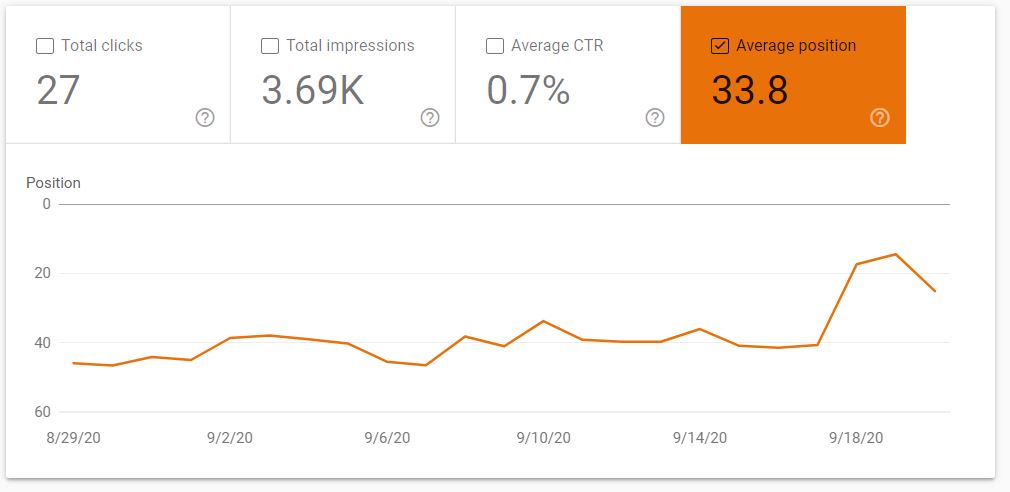- +1 512-591-8295
- [email protected]
- Mon - Fri: 9:00 - 16:00

Let’s walk through how you can quickly and easily check the overall results of your search engine optimization activities in five minutes or less.
This quick method is perfect for those times when you need to go in and do a quick check, but you don’t have tons of time to really dive into all of the reports that you can run and the different software you can use to see if your efforts are indeed getting results.
This quick and easy method gives you a great insight and doesn’t take you a lot of time or effort.
One of the best tools you can use for this type of reporting is Google Search Console. If you don’t have this set up on your website yet, you want to go and do it now … and it’s really easy if you’ve already installed Google Analytics (which you should already have done). Getting your website verified in Google Search Console usually only takes a couple of clicks.
I’m not going to delve into everything Google Search Console can show you, but I’m going to show you the quick and easy method we check every now and then when we only have a few minutes to determine if overall search engine optimization efforts have been effective.
Start by going to https://search.google.com and click on the Performance tab in the left menu, then click Open Report.
Then change the date range to a custom date that is long term, in this case a little bit longer than we’ve been working on the client’s website.

This is the default view, and it’s easy to note quick that the purple and blue lines are going up as an overall trend.
The purple line is total impressions and blue is total clicks. Helpful information, but we’re not looking at either of these two lines for this quick, down and dirty report.
Uncheck “total clicks” and “total impressions” and check only “average position”.

Don’t worry about the ups and downs … that’s normal because your traffic and position and more will vary on a day to day basis.
The overall average position number is the one we’re going to keep our eye on as we look through this.
In the case study we’re working on, over the past three years in total the average position for our client was 48.4.
This number is the average search position for all terms that have been searched and resulted in the website being shown as a result. Keep in mind, sometimes these words aren’t actually the search terms that you want to be raking for.
As an example, a different client we started working with, a self storage business, we noticed that two of their top keywords they were ranking for were Chinese dictionary and Russian dictionary. Obviously neither of these apply in any way to their business. In the past, some bad SEO had been done on their behalf, and they were still experiencing the results of that work.

So this “average position” includes all search terms, perhaps even ones you aren’t wanting to be found for, but it’s a great overall number to keep an eye on.
For the client in our example, over the past three years, the average position for all search terms is 48.4, which is down on the bottom of page 4 since there are about 10 results per page. She actually held pretty steady around this position for the first 18-24 months of having a website – around 50.7 when the website first began and had little to no content, to around 48.4 after about a year of posting six new blog posts per month.
Now you can quickly change to some of the other preset dates using the date selector, and changing the range to the past 16 months, it remains 48.4 (we started working with this client about 12 months ago). Still good information to be able to quickly compare where the results were at before compared to now.
Changing the dates again to the past 12 months, it moves the overall position to 48.2 – so that is trending in the right direction. Keep in mind this reflects rankings from right around the time we started, and every day through now. In general, we start to see an upward trend.
Keep in mind, this particular client is using NO paid advertising – no Google Ads, no Facebook Ads – this is all organic reach. And in this case, the client doesn’t even offer a product or service yet – they’re building the website, using blogging and other methods, to start building awareness prior to their launch in 2021. While not all businesses have the luxury of spending a long time building this time of awareness and authority before the launch of a product or service, the strategies being used here can have the same positive impact for any business. The main point to keep in mind is that it’s all organic and no paid advertising.
Also remember, SEO is always a long-term, ongoing strategy.
So, we’ve moved from 48.4 at 16 months, to 48.2 average for 12 months. Switching to the pre-selected range of 6 months, it moves to 46.3 – still trending in the right direction. Switching the date selector again to the last 28 days, we jump to 42.8 – that’s top of page 4 of search results.
Yes, of course we all want to be on page one, and that’s really easy to do with paid advertising, and when using Google maps for a local brick and mortar store, remember this client has neither.
The next thing to look at is below the chart. There’s a list of the actual search terms that were used during the date range you selected, with those most used at the top of the list.
This is where you can begin to check if you’re ranking for the search terms that you actually want to rank for.
Looking at this client’s top search term in the three year time period that her website has been in existence, clicking on her top search term, we see that it’s actually in position three. That’s on page 1 of Google search results, and it’s actually one of the terms we have been actively optimizing for on her website. Instead of getting some of the really random ones, this is one we’ve worked on and have definitely moved it up pretty consistently to position three to one.
This is good, it quickly tells us that when someone searches for this particular term, she’s showing up as one of the first three results.
This is how you can use Google Search Console to see if our efforts on search engine optimization are working.
On those days that you feel like you’re going in and doing search engine optimization activities, and you wonder if it’s ever going to make a real difference (especially if, in a case like this client, you don’t actually have sales figures that can be a quick reflection of success), using this method is one way to see that, yes, your efforts are working.
Remember SEO is a long-term strategy. Obviously this isn’t the only number or even the only report that you’re going to want to check, but it can give you some info for a quick update.
This is exactly the type of information that we teach you in our New SEO Accelerator – the do-it-yourself search engine optimization program.
In addition to receiving a weekly PDF report that we email to you, that pulls together information from a variety of different sources and tells you some technical aspects you need to be updating on your website, this report an help you keep track of how well you’re doing.
We also teach you the exact strategies we use when we are performing search engine optimization for our clients. This would include strategies such as the technical pieces of SEO, as well as some of Google’s most recent algorithm updates and the one thay have planned for 2021; along with combining some of the best practices from marketing in general, so that not only can you get extra traffic to your website but you can increase conversions once they get there.
All of this in a DIY SEO program.
So if you’re in the process of doing it yourself, or you’re interested in doing it yourself, you definitely want to check out this New SEO Accelerator program, because you don’t have to do it completely alone; you can get the support of our entire SEO team.
We also have done-for-you SEO solutions as well, if you prefer to hand this strategy over to the experts.
Have you used this Google Search Console report? Do you find the “average position” data helpful?
Curious how you can increase your website traffic?
Get solid marketing strategies, designed for entrepreneurs on the track to 7-figures and beyond, right in your inbox.

This website uses cookies to ensure you get the best experience on our website. By continuing to use the website, you agree to our use of cookies. We do not share or sell your information. More info
